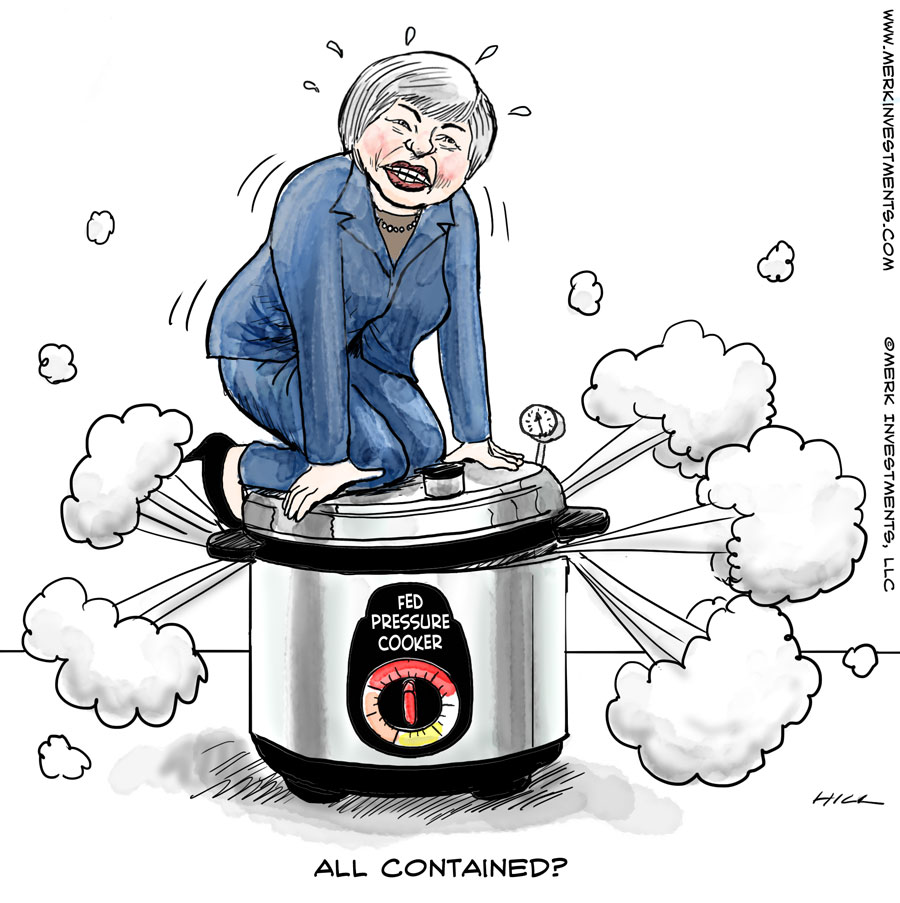Home » Posts tagged 'Axel Merk'
Tag Archives: Axel Merk
How I Own My Gold
How I Own My Gold
Those who own gold often argue how to best own it. I encourage anyone holding gold to assess the pros and cons of different choices of gold ownership to make an educated rather than emotional decision. Let me explain.
I commissioned the above cartoon back in 2011 in response to an assertion by CNBC’s Steve Liesman no one would accept a gold coin in a grocery store. My take was that, hell, if I offered a gold coin, I’m pretty sure I would find a taker if I wanted to exchange it for some groceries.
There appears to be an eternal back and forth between those that “love” and those that “hate” gold; that discussion, in my humble opinion, misses the point. It is striking how this shiny metal raises emotions by both friends and foes. Maybe it is because gold is so simple, so pure, the fact that there are fairly few industrial uses for it, that emotions take over in discussing gold’s merits.
The historic context matters. Gold has been used as money for millennia; yet some say it is a “barbaric relic” preferring to use fiat currencies for commerce. All major currencies are fiat currencies these days, that is, they can be created ‘out of thin air’, by the stroke of a keyboard at a central bank. The modern world of fiat currencies, is in place in its current form since 1971 when Nixon ‘temporarily’ abandoned the last link to gold. The very notion of currency has been used in new ways as promoters of virtual tokens subject to a decentralized creation and sharing methodology referred to as crypto-currencies have touted that they will disrupt the way we transaction and store value. The value of crypto-currencies, of course, has been highly volatile, and none of this should be construed as an investment recommendation.
…click on the above link to read the rest of the article…
Why The Markets Are Overdue For A Gigantic Bust

r.classen/Shutterstock
Why The Markets Are Overdue For A Gigantic Bust
If you’re not familiar with the term, ‘confirmation bias’ suggests that once we’ve invested time and emotional energy into developing a worldview, we’ll then seek information to confirm that view.
After writing about the economy for so many years, I’m now so convinced that we can’t print our way to prosperity that I find myself seeing signs confirming this view everywhere, every single day. So that’s the danger to be aware of when listening to me. I’m going to keep repeating this mantra and Im going to keep finding data that supports this view.
Based on lots of historical inputs, I have concluded that Printing money out of thin air can engineer lots of things, including asset price bubbles and the redistribution of wealth from the masses to the elites. But it cannot print up real prosperity.
As much as I try, I simply cannot jump on the bandwagon that says that printing up money out of thin air has any long-term utility for an economy. It’s just too clear to me that doing so presents plenty of dangers, due to what we might call ‘economic gravity’: What goes up, must also come down.
Which brings us to this chart:

The 200 bubble blown by Greenspan was bad, the next one by Bernanke was horrible, but this one by Yellen may well prove fatal. At least to entire financial markets, large institutions, and a few sovereigns.
It’s essential to note that more than two-thirds of the net worth tracked in the above chart is now comprised of ‘financial assets.’ That is, paper claims on real things.
…click on the above link to read the rest of the article…
Fake Risk, Fake Return?
With seemingly everyone from the blogosphere to the Tweeter-in-chief chiming in on fake news, have investors considered their risk/return profile may also be “fake”? When it comes to investing, who or what can we trust, is the market rigged, and why does it matter?
For eight years in a row now, an investment in the S&P 500 has yielded positive returns.1 In recent years, expressions like “investors buy the dips” and “low volatility” have become associated with this rally.
In the “old days”, investors used to construct portfolios that, at least in theory, provided a risk/return profile that they were comfortable with. For better or worse, I allege those “old days” are over. To be prepared for what’s ahead, let’s debunk some myths.
The system is rigged
For those that say the system is rigged, I concur. In my assessment, central banks are largely responsible for a compression of “risk premia.” All else equal, quantitative easing and its variants around the globe have made assets from equities to bonds appear less risky than they are. This is at the very core of central banks efforts to entice investors to take risks, as risk taking is key to making an economy grow. In practice, central banks have foremost pushed up financial assets, but have largely disappointed in generating real investments. As a result, those holding financial assets have disproportionally benefited.
Hidden risks: liquidity
When I look at market risks, I feel like investors are in ‘la la land,’ ignoring the moonlight. Pardon the pun, I believe investors completely underappreciate hidden risks in the markets, notably the risk of liquidity evaporating. In today’s ETF driven world, to make ETFs track underlying indices, there are so-called market makers providing liquidity.
…click on the above link to read the rest of the article…






